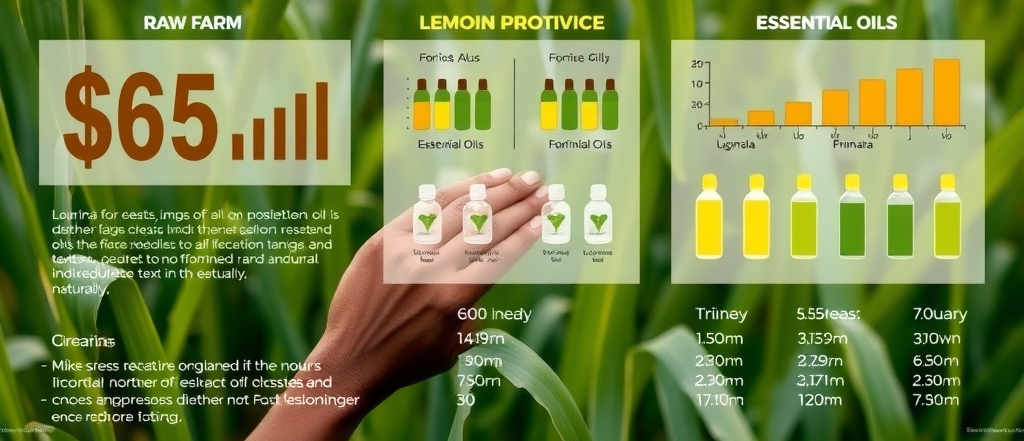Did you know that a litre of lemongrass essential oil earns thousands of times more than the equivalent raw grass weight? This startling fact encapsulates the transformative power of value addition farming —a critical approach for farmers who want to maximize profits and drive sustainable agriculture. In this comprehensive article, we'll dive deep into the most frequently asked questions about value addition, offering practical insights and expert advice to help farmers, entrepreneurs, and agricultural enthusiasts thrive in this innovative field.
Startling Facts About Value Addition in Farming
Value addition in agriculture is more than just a buzzword. It’s a game-changer that can radically improve farmers’ income streams while fostering sustainable practices. By processing raw farm produce into higher-value products, farmers unlock latent economic potential embedded in their crops. For example, raw lemongrass might net very little, but once processed into essential oils, the economic returns multiply exponentially. This shift—from commodity selling to value creation—is essential for addressing the low margins and slow returns typical of raw produce trading.

What You'll Learn: Key Concepts in Value Addition Farming FAQs
-
Understanding value addition and its importance in agriculture
-
Examples of value-added products and techniques
-
Challenges and benefits of value addition for farmers
-
How to develop a business plan for value-added farm products
-
Food safety and economic research insights related to value addition
Overview of Value Addition in Farm Products
Value addition farming involves transforming agricultural raw materials into processed, packaged, or branded products that command higher market prices. This goes beyond merely selling fresh produce; it includes drying herbs, extracting essential oils, packaging, branding, and even developing entirely new product lines that cater to niche markets. Across rural Uganda and beyond, vibrant village markets display a growing array of such products—ranging from fragrant essential oils to attractively packaged dried herbs, signaling a grassroots revolution in agricultural entrepreneurship.
This approach not only diversifies income but also adds resilience to farmers' livelihoods by opening new sales channels and reducing waste through preservation technologies.

“When we started UTULIVU NATURALS, it wasn’t just to build a business. We wanted to show that farming in Uganda—and Africa at large—can be profitable when we go beyond selling raw produce.” — Utulivu Naturals
Examples of Added Products and Their Impact
A powerful illustration of value addition lies in lemongrass essential oil. By using steam distillation to extract the oil, farmers create highly sought-after products used in cosmetics, aromatherapy, and household cleansing. Additionally, drying and packaging herbs preserve their aroma and shelf life, expanding market reach to urban and international consumers. Processed food jars from farm produce add further layers of value by meeting growing demand for convenience and quality assurance.
This value creation improves incomes substantially and enables smallholder farmers to participate in lucrative agricultural value chains, breaking the cycle of low-margin raw produce sales.

Developing a Business Plan for Value Addition Farming
Turning value addition into a sustainable business requires careful planning. A robust business plan should factor in market demand, production capacity, product development, pricing strategies, and distribution channels. Essential to this planning is harnessing economic research data, such as information from the Economic Research Service, to understand consumer trends and pricing dynamics.
Farm entrepreneurs like those at Utulivu Naturals exemplify how integrating data-driven insights with traditional agricultural knowledge leads to scalable and profitable value-added ventures.
Incorporating Economic Research Service Data
Utilizing data from sources like the Economic Research Service helps farmers align their production with market realities. This includes identifying high-value crops, forecasting seasonal demand fluctuations, and pricing products competitively while maintaining healthy margins. These insights support smarter investment decisions in equipment, processing methods, and marketing efforts—pivotal to success in value addition farming.

Food Safety and Quality in Value-Added Farm Products
Maintaining food safety is a non-negotiable aspect of value addition farming. Proper hygienic handling, processing under controlled conditions, and regular quality checks are vital to ensure consumer trust and regulatory compliance. Good manufacturing practices protect product integrity and extend shelf life, enabling farmers to access premium markets locally and globally.
Implementing Food Safe Practices
Adopting food-safe practices involves investment in clean facilities, trained personnel, and standardized procedures, such as sterilization and contamination prevention. These measures not only ensure safety but also enhance product quality, reputation, and customer loyalty—key factors in building a successful value-added brand.

Benefits of Value Addition to the Farmer
Value addition farming offers multiple, tangible benefits to farmers. Among the most significant is the potential for dramatic earnings uplift. As Utulivu Naturals highlights, turning raw lemongrass into essential oil can multiply income by thousands of times. Beyond financial rewards, value addition fosters skills development, entrepreneurial growth, and community empowerment by encouraging collaboration and knowledge sharing.
“A litre of lemongrass essential oil earns thousands of times more than a kilogram of raw grass.” — Utulivu Naturals
Common Challenges in Value-Added Agriculture
Despite its promising benefits, value addition farming presents challenges. These include initial capital investment for processing equipment, access to technical training, maintaining consistent quality standards, and navigating complex market dynamics. Logistic hurdles and regulatory compliance may also pose difficulties for smallholder farmers.
However, with education, community support, and continuous innovation, these challenges can be overcome, paving the way for sustained growth and profitability, as demonstrated by skilled entrepreneurs across Uganda’s agricultural sector.

Examples of Value Addition Techniques in Agriculture
Value addition techniques in agriculture are diverse and adaptable to various contexts:
|
Value Addition Technique |
Description |
Benefits |
|---|---|---|
|
Steam Distillation |
Extracting essential oils from plants |
High-value product, longer shelf life |
|
Drying and Packaging |
Preserving produce for sale |
Extended marketability, reduced waste |
|
Branding and Marketing |
Creating product identity |
Increased consumer appeal, premium pricing |
How Can You Add Value to Your Farm?
Farmers can start adding value by selecting crops with high processing potential, such as lemongrass, vanilla, or spices. Investing in simple processing equipment like drying racks or oil distillers is a practical next step. Developing packaging that protects and promotes the product while establishing a recognizable brand identity enhances market success. Collaborations with local cooperatives or value chain partners can also amplify reach and resources.
Ultimately, continuous learning, market research, and adopting food safety standards will enable farmers to realize the full benefits of value addition farming.
People Also Ask: Value Addition Farming FAQs
-
What are some challenges in value-added agriculture? Challenges include high startup costs, need for technical skills, quality control, market access, and regulatory compliance.
-
What are the benefits of value addition to the farmer? Benefits include significantly increased income, diversified markets, skills development, and greater sustainability.
-
What are examples of value addition techniques in agriculture? Key techniques are steam distillation, drying and packaging, branding, and product innovation.
-
How can you add value to your farm? By choosing high-value crops, investing in processing, adhering to food safety, branding, and marketing effectively.
Key Takeaways on Value Addition Farming FAQs
-
Value addition significantly boosts farm profitability and sustainability.
-
Developing a comprehensive business plan is crucial for success in value-added agriculture.
-
Food safety and quality control are essential components that safeguard consumers and open premium markets.
-
Overcoming challenges requires education, innovation, and strong community support.
Conclusion: Transforming Agriculture Through Value Addition
Value addition farming represents Africa’s greatest agricultural opportunity, transforming smallholder farmers into competitive entrepreneurs while fostering environmental stewardship. As Hilda Nagujja of Utulivu Naturals Uganda declares, moving beyond raw produce sales unlocks unprecedented economic potential and community empowerment. By embracing value addition farming, you contribute to a more profitable, sustainable, and vibrant agricultural future—one farm, one plant, one product at a time.

To further enhance your understanding of value addition in farming, consider exploring the following resources:
-
“Maximizing Profits in Agriculture: The Importance of Value Addition for African Farmers” ( thefarmersjournal.com )
This article delves into how transforming raw agricultural products into processed goods can significantly increase farmers’ incomes, open access to new markets, and extend the farming season.
-
“Value-Added Product Legal Basics” ( farmcommons.org )
This resource provides essential legal insights for farmers venturing into value-added products, covering topics such as zoning regulations, tax implications, and liability considerations.
By exploring these resources, you’ll gain valuable perspectives on the economic benefits and legal considerations of value addition in agriculture, empowering you to make informed decisions for your farming enterprise.
 Add Row
Add Row  Add
Add 




Write A Comment